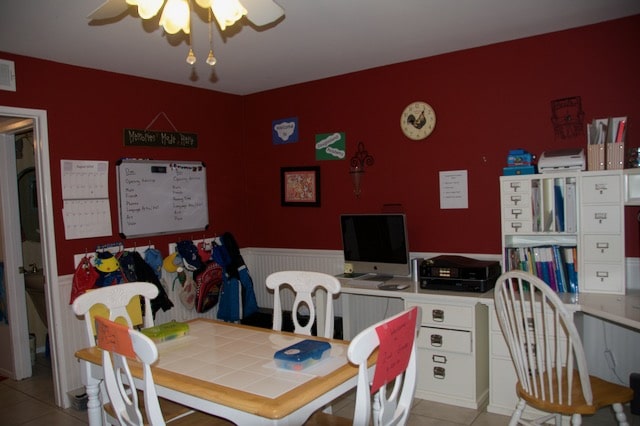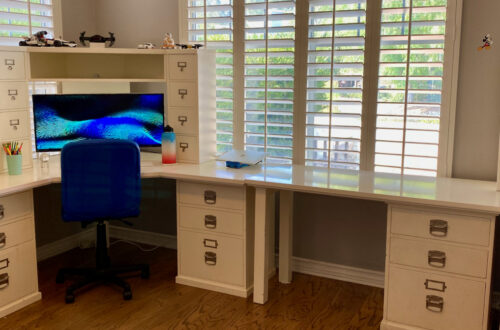
One-Room Schoolhouse Homeschool
Homeschooling, or virtual schooling, multiple kids means managing different lessons, levels, and schedules. It can get overwhelming!!! How do we teach more than one child at home without losing our patience and our sanity?
Let’s create our own One-Room Schoolhouse for our homeschool!
The Beginning of our One-Room Schoolhouse
I remember starting the virtual school journey with my eldest son in Kindergarten. There was one schedule to move through during the day. I could completely focus on him and the lessons of the day. My younger son would play and listen to the stories with us. The boys would take their recesses together and then I would get back to school with Ken.
I had two years of only homeschooling one child. I got used to managing one lesson in each subject per day. I had found a routine that worked for us.
And then Dan started Kindergarten.
Things were about to get interesting. How would I manage a Second Grader and a Kindergartener in the same schoolroom? Would I be spending twice as long at this virtual schooling?
I remember that I was worried about the school day and that I wanted to make sure that I would be able to give each kid enough attention. There was one of me and two of them! What would I do?
Many of you are beginning this virtual school journey with several kids at home. You might not have had the onramp into schooling at home that I did. You began this process with kids at all different grade levels at home.
How is it possible to be successful with so many grades to teach?
We need a framework to help us be successful!
One-Room Schoolhouse
When we homeschool, or virtual school, in many ways we are recreating the one-room schoolhouse in our home.
For many years, across rural America, communities would establish a one-room schoolhouse for their children. There weren’t enough kids to break out into separate grades, so everyone learned together. One, teacher was hired to deliver the lessons to children in grades one through eight. This was a large grade span! How did she do it?
The older kids, the ones who were capable of learning on their own, were typically seated in the back of the classroom. They would be asked to help the younger students, and could also be capable of learning on their own.
The teacher would then be freed up to teach reading and writing to the younger children.
There were also things that the entire classroom could work on together. Read aloud could be done as an entire classroom. Also, music and drama productions could be done as a class. Recess would be enjoyed as an entire schoolhouse, with the older and younger kids playing together.
Believe it or not, one-room schoolhouses were the norm in America until about the time of World War One. There were not enough kids in rural communities to produce different schools. In fact, there are still a few one-room schoolhouses in remote areas of America.
A Unique Type of Socialization
As you embark on this journey of homeschooling, or virtual schooling, I’d like you to take the perspective that you are now a teacher in a one-room schoolhouse. You have children of different grade levels all working together in your home. The older children have the ability to coach and mentor the younger children. This can provide a unique opportunity for your children to learn how to interact with people of all ages and ability levels.
This sense of community is different than the socialization that takes place when kids of one age meet together in a classroom. In a single grade environment, the teacher is uniquely focused on the learning objectives of that particular grade.
There are accommodations made, as necessary, for high and low-performing students, but generally the adjustments are not as major as one would need to make with students of multiple grades.
This is the learning environment that many of us are familiar with. Homeschooling was not nearly as popular when I was growing up as it is now. I went through a traditional brick and mortar school environment. I wasn’t in an English class with kids who were older than I was.
I needed a different way to approach the learning environment in our home.
I decided that the one-room schoolhouse vision was going to guide me as I learned how to teach my two boys at home.
One-Room Schoolhouse Approach
Primary School Room
To make the one-room schoolhouse approach work for your homeschool, there needs to be a primary learning location set up in your home. This can be a dedicated school room or an area in your living or dining room that you have set aside for learning.
In our old home, we decided to repurpose the space off of our kitchen, the traditional family room, into a school area. We didn’t use that room for TV viewing or relaxing, in fact, it was once a playroom for the toddlers. We had a table in the room, and it was large enough to hold a few desks.
In your home, it may make more sense to place a few bookshelves in the dining room and use the dining table for learning.
In our current home, we have a dedicated school room with individual desks for all three of us. I can see this room from the family room and kitchen, which makes supervision easy. If I need to work with a boy individually we either work on the couch, or I will pull up a chair next to them in the room.
There are so many ways to make a learning area in your home. As you consider the one-room schoolhouse approach, I’d like you to think about how you can have all your children learning together in one area of your home. This will help you be available to teach and supervise without walking all through the home.
Joint Learning When Possible
Whenever it is possible to teach all of your kids at once, make sure you do just that! In the elementary years, we would all sit on the couch and I would do read-aloud time together. We would read through both boys’ literature stories for the day. They would also get to eat a snack and snuggle under their favorite blanket.
We would usually time this to be around 10 AM. This was a couple of hours after we started school because they got up early in elementary. They were usually ready for recess by then. So, we would do our morning reading, and then they would take a break together.
Other subjects that I would try to work on together would be science and art. In our k12 curriculum, the science units would usually have similar experiments across the grade levels. Sometimes these experiments would occur at different times of the year. I would always look ahead and try to see which experiments were similar. Then, we would do the older child’s experiment, but I would have my younger son participate. It was a great way to have them work together. I would then mark off both of the lessons in the different grade levels.
I would also teach art together. They would have different art history lessons, but I would try to have them both working on a project in the same medium. We would all paint together, or do sculpture together. This might mean that I needed to do a different art lesson than the exact one assigned that day. But, it meant that only one set of supplies needed to be gotten out on a given day.
Recesses Together
My kids have always taken their recesses and lunch breaks together. They would play outside together when they were younger, play games together, build lego masterpieces in the living room, and also have the occasional sibling spat.
They are in high school now, so they don’t take morning recesses anymore! But, they still enjoy playing video games together and going out on walks together for their PE. It is truly a joy for me to see how much they enjoy one another’s company- at least most days!
I encourage you to plan for recesses and lunch breaks together! Your children will enjoy the company of their siblings, and it will increase and deepen their relationships. They may not always want to do the same thing all the time, but they will have the opportunity to do that collective recess play that would naturally happen in a school environment, It might look different at home, but it is still valuable!
Schedule Independent Tutoring Time
In your one-room schoolhouse, there will be times when your children need one on one tutoring. Even now, while my children are in high school, there are still times when they would like to work with me one on one.
Please schedule this time! If you don’t put it on your daily routine or calendar, then I can guarantee you that all your kids will want tutoring at the same time. Or, they will want it when you are ready to take your midday break.
You may want to have a morning meeting with each of your children to go over their schedules. Or perhaps, you schedule an afternoon meeting to go over their work for the day.
You can be flexible with how you approach the one on one time. But please, make sure to schedule it so that you don’t get overwhelming with requests!
Acknowledge You are One Person!
You are one person. You cannot teach everything all at once. There may be times when a child needs to wait to get the answer to their questions.
That is completely ok! If you are busy working with one child, and another demands your attention, please teach them to wait for their turn.
Unless they are hurt. Then, tend to the hurt one!
Waiting is an important skill that all of us need to learn. Students learn to wait in the classroom to get their questions answered, and we can teach them this skill as well.
I recommend you pick a place to sit when you are in teacher mode and then help the children as needed. When my kids were in early elementary school we would use the kitchen table to homeschool. I would be in the middle and available to coach each child as needed.
Encourage Sibling Tutoring
If you have older children, then you have a built-in tutoring and support system in your one-room schoolhouse. Your older kids can help the younger kids with skills like reading and math facts. Your older child will get the opportunity to review key skills while helping out a younger learner. This can teach compassion and patience.
This does not mean that your older children should spend all day tutoring their siblings. That would not be fair to them. What it does mean is that your kids can work together and support one another in the learning process.
Sometimes my younger son will help my older son with long-range project planning, and in return, my older son will help his brother with a difficult math lesson.
It is a wonderful thing to watch your children learn from each other!
Teach Independence
To run an effective one-room schoolhouse homeschool, your children need to learn how to work independently. You cannot hand-deliver each lesson to each of your children. You will run out of hours in the day!!!
These independent learning skills can begin very early in elementary. If your curriculum has learning games or apps built into its ecosystem, then have your children do those independently as soon as possible.
I decided to use a Spelling App on the iPad to teach the spelling curriculum. I would enter the school assigned words into the list each week, and then the kids would do their spelling independently.
In fact, I had a section of their day which was organized specifically for independent learning. They would work on spelling, handwriting, independent reading, and math facts using an app on their iPad.
When one child was working independently, I could work with the other child on directed learning.
As your children get older, they should be more and more capable of learning independently. This is an important goal of your one-room schoolhouse. We have the ability to raise self-directed learners who are capable of reading, synthesizing, and learning on their own.
That’s not to say that you are completely out of a job! You will still be supervising and offering counsel as needed. But, the time for you to directly teach will reduce as they get older.
You have the opportunity to design a family one-room schoolhouse in your home. You can create a space that encourages all your children to grow and learn. As your children grow, the space may need to change to reflect their current needs. But, the purpose doesn’t change. We are creating a home learning environment so that our children can all learn together!
Jennifer Douglas
Jennifer is the author of "A Breast Cancer Journey: Living it One Step at a Time," breast cancer survivor, and patient advocate. Her book, published in 2023 by Bold Story Press, is an encouraging guide for breast cancer patients. It contains first-hand information, organized by topics, to help readers navigate the diagnosis, treatment, and recovery from breast cancer. Her writing emphasizes emotional, mental, and physical well-being along with empowered decision-making.


You May Also Like

Back To School 2021: One in College, One in High School
August 25, 2021
How to Stay on Track with Virtual School
September 11, 2020

Your One-Room Schoolhouse writing has given me many ideas to implement. Thank you!
Kathy, I’m so glad that you found useful ideas to try. Let me know what works for you and your family!